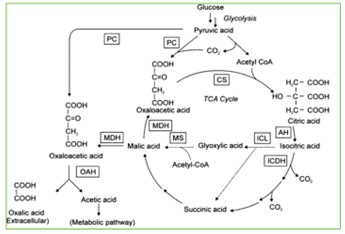Fermentation and Cell Culture
Fermentation and Cell Culture

There are many possible fermentations that may be carried out using liquefied slurries of lignocellulosic biomass materials, in our case this would be corn stover. The hydrolysis of the cellulosic and cellulosic components in corn stover result in fermentable hexose and pentoses. The hexose, glucose, may be utilized through the citric acid cycle (figure) to from citric acid, of course, but in some microorganisms the citric acid cycle may be redirected to oxalic acid by controlling the pH of the fermentation. The metabolic yield of oxalic acid from glucose is 1:1, i.e., all of the carbons that are introduced to this metabolic pathway would be converted to oxalic acid. This is significant since cellulose that is used in our fermentation captures CO2 from the atmosphere and concentrated the CO2 in a recoverable form by a factor of 106 or more. Oxalic acid, formulated into cement used for construction sequesters this carbon in as a stable calcium salt (same chemistry as that which forms kidney stones) and in effect removes CO2 from the atmosphere. This research is investigating the fermentability of corn stover slurries from A. niger to produce oxalic acid using oxygen transfer for fungal growth and pH control for directing the TCA metabolism to obtain high yields of oxalic acid.
